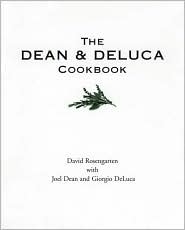 Two of my favorite cookbooks-- from which most of "my own" recipes have been adapted— are based on stores that sell (or used to sell) prepared foods in New York City. The Silver Palate spearheaded a cooking renaissance of sorts in the US; Dean and DeLuca continues to stock the name-brand fancy foods of the world.
Two of my favorite cookbooks-- from which most of "my own" recipes have been adapted— are based on stores that sell (or used to sell) prepared foods in New York City. The Silver Palate spearheaded a cooking renaissance of sorts in the US; Dean and DeLuca continues to stock the name-brand fancy foods of the world.What distinguishes the two cookbooks is rather fascinating. The recipes in each book are determined by the foods primarily in stock at either store. In the case of Dean and DeLuca, this means that the recipes feature once-exotic and largely fresh, imported ingredients: the fruits, vegetables, and meats that the store tends to keep on hand. It is, after all, a supermarket first, a prepared-foods dealer second. Thus: shad in season; different varieties of potatoes, greens, and such.
The Silver Palate cookbook features recipes that use lots and lots of preserved foods: foods in jars, such as jams, jellies, mustards, dried figs, and the like.
This is especially useful for the home cook; the Dean and DeLuca cookbook (like Mark Bittman's How to Cook Everything and the Larousse Gastronomique) is a marvelous resource when you find yourself the owner of a bundle of dandelion greens or sorrel. The Silver Palate is useful when you're trying to figure out what to do with a passel of chicken thighs.

For mother's day, for instance, we made an old favorite from the Silver Palate's "Good Times" cookbook-- Apricot and Currant Chicken, which uses nearly a jar of marmalade and several handfuls of dried fruit. It's even listed as a mother's day recipe, which helps matters considerably.
We made the recipe with chicken thighs instead of with quartered chickens, because they cook evenly and well under high temperatures, due to their high fat content. Here's a digest of the recipe:
Lay 5-6 pounds of chicken thighs (we used bone-in thighs, but boneless would be easy, too) in a roasting pan. Make sure they still have their skins, and position them skin side up. Season with salt and pepper, and sprinkle some grated ginger (a thumb-sized piece or so) over the chicken. Spread 1 1/2 cups of orange marmalade over the chicken, and pour 1/3 cup of orange juice, and 1/3 cup of apple juice, over everything. Roast for 20 minutes in a 375° oven.
Remove the roasting pan from the oven, and add two handfuls of coarsely-chopped dried apricots and the same amount of dried currants, making sure to submerge them in the liquid so they don't scorch. Bake for 30-40 minutes, until the chicken is cooked through (this takes less time with thighs than with quartered chickens), and the skin is nice and browned.
Serve with couscous (as we did) or with some kind of rice dish or pilaf.
Such sweet-savory meats are the Rosso- Lukins specialty. But it was only recently that I realized the material nature of this flavor preference: it's remarkably savvy to base your in-store staple dishes on easily stocked goods. No need to worry about whether the flavoring agent for "Apricot and Currant Chicken" is in season. Imagine if it were based on fresh apricots. This would mean that either the dish would be available only in the fall, or else would require expensive (and perishable) imported apricots.
Mind you, the "Good Times" cookbook does feature seasonal dishes- -indeed, this is the principle of the follow-up to the initial Silver Palate book. But I admire the distinction of the first effort in particular: to use preserved foods is both economically savvy and delightfully old-school.
Preservation, after all, is an art form. But so is cooking that makes use of preserved foods.
No comments:
Post a Comment